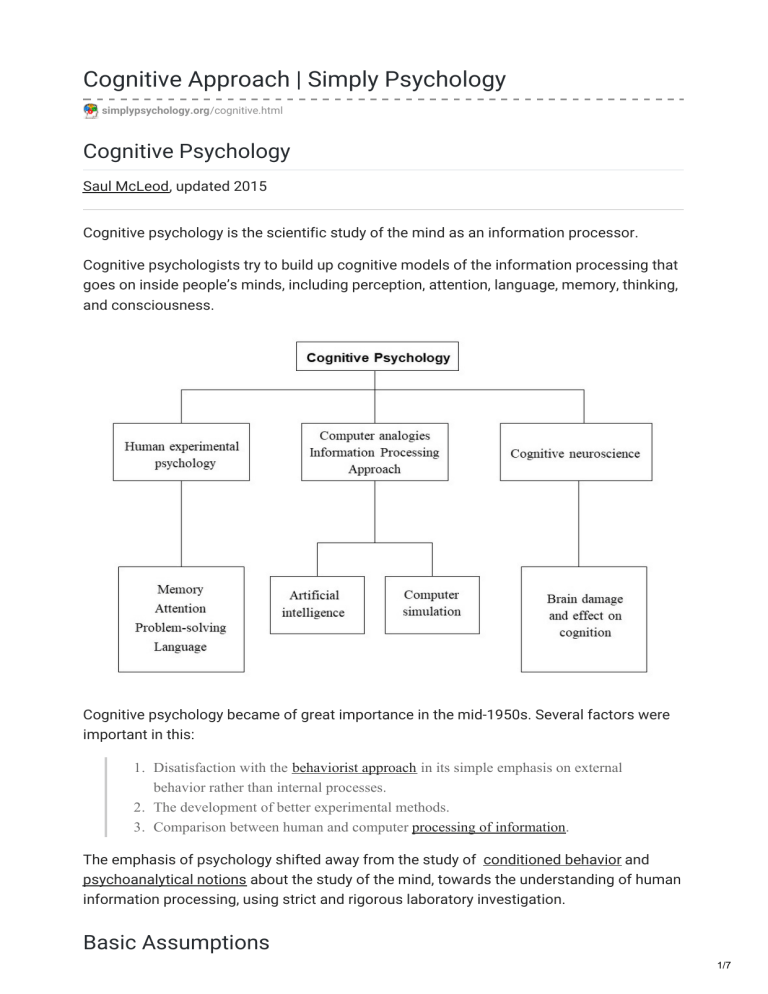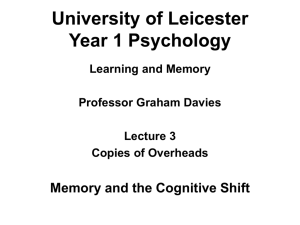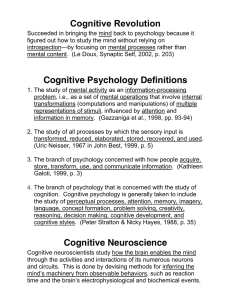
Cognitive Approach | Simply Psychology simplypsychology.org/cognitive.html Cognitive Psychology Saul McLeod, updated 2015 Cognitive psychology is the scientific study of the mind as an information processor. Cognitive psychologists try to build up cognitive models of the information processing that goes on inside people’s minds, including perception, attention, language, memory, thinking, and consciousness. Cognitive psychology became of great importance in the mid-1950s. Several factors were important in this: 1. Disatisfaction with the behaviorist approach in its simple emphasis on external behavior rather than internal processes. 2. The development of better experimental methods. 3. Comparison between human and computer processing of information. The emphasis of psychology shifted away from the study of conditioned behavior and psychoanalytical notions about the study of the mind, towards the understanding of human information processing, using strict and rigorous laboratory investigation. Basic Assumptions 1/7 Mediational processes occur between stimulus and response: Behaviourists rejected the idea of studying the mind because internal mental processes cannot be observed and objectively measured. However, cognitive psychologists regard it as essential to look at the mental processes of an organism and how these influence behaviour. Instead of the simple stimulus-response links proposed by behaviourism, the mediational processes of the organism are important to understand. Without this understanding, psychologists cannot have a complete understanding of behaviour. Psychology should be seen as a science: Cognitive psychologists follow the example of the behaviourists in preferring objective, controlled, scientific methods for investigating behaviour. They use the results of their investigations as the basis for making inferences about mental processes. Humans are information processors: Information processing in humans resembles that in computers, and is based on based on transforming information, storing information and retrieving information from memory. Information processing models of cognitive processes such as memory and attention assume that mental processes follow a clear sequence. For example: Input processes are concerned with the analysis of the stimuli. Storage processes cover everything that happens to stimuli internally in the brain and can include coding and manipulation of the stimuli. Output processes are responsible for preparing an appropriate response to a stimulus. Information Processing The cognitive approach began to revolutionize psychology in the late 1950’s and early 1960’s, to become the dominant approach (i.e., perspective) in psychology by the late 1970s. Interest in mental processes had been gradually restored through the work of Piaget and Tolman. Tolman was a ‘soft behaviourist’. His book Purposive Behaviour in Animals and Man in 1932 described research which behaviourism found difficult to explain. The behaviourists’ view had been that learning took place as a result of associations between stimuli and responses. 2/7 However, Tolman suggested that learning was based on the relationships which formed amongst stimuli. He referred to these relationships as cognitive maps. But it was the arrival of the computer that gave cognitive psychology the terminology and metaphor it needed to investigate the human mind. The start of the use of computers allowed psychologists to try to understand the complexities of human cognition by comparing it with something simpler and better understood, i.e., an artificial system such as a computer. The use of the computer as a tool for thinking how the human mind handles information is known as the computer analogy. Essentially, a computer codes (i.e., changes) information, stores information, uses information, and produces an output (retrieves info). The idea of information processing was adopted by cognitive psychologists as a model of how human thought works. The information processing approach is based on a number of assumptions, including: 1. Information made available from the environment is processed by a series of processing systems (e.g., attention, perception, short-term memory); 2. These processing systems transform, or alter the information in systematic ways; 3. The aim of research is to specify the processes and structures that underlie cognitive performance; 4. Information processing in humans resembles that in computers. Mediational Processes The behaviorists approach only studies external observable (stimulus and response) behavior which can be objectively measured. They believe that internal behavior cannot be studied because we cannot see what happens in a person’s mind (and therefore cannot objectively measure it). In comparison, the cognitive approach believes that internal mental behavior can be scientifically studied using experiments. Cognitive psychology assumes that a mediational process occurs between stimulus/input and response/output. 3/7 The mediational (i.e., mental) event could be memory, perception, attention or problem solving, etc. These are known as mediational processes because they mediate (i.e., gobetween) between the stimulus and the response. They come after the stimulus and before the response. Therefore, cognitive psychologists’ say if you want to understand behavior, you have to understand these mediational processes. History of Cognitive Psychology Kohler (1925) published a book called, The Mentality of Apes. In it he reported observations which suggested that animals could show insightful behaviour. He rejected behaviourism in favour of an approach which became known as Gestalt psychology. Norbert Wiener (1948) published Cybernetics: or Control and Communication in the Animal and the Machine, introducing terms such as input and output. Tolman (1948) work on cognitive maps – training rats in mazes, showed that animals had an internal representation of behavior. Birth of Cognitive Psychology often dated back to George Miller’s (1956) “ The Magical Number 7 Plus or Minus 2.” Newell and Simon’s (1972) development of the General Problem Solver. In 1960, Miller founded the Center for Cognitive Studies at Harvard with famous cognitivist developmentalist, Jerome Bruner. Ulric Neisser (1967) publishes "Cognitive Psychology", which marks the official beginning of the cognitive approach. Process models of memory Atkinson & Shiffrin’s (1968) Multi Store Model . 4/7 Process models of memory Atkinson & Shiffrin’s (1968) Multi Store Model . Cognitive approach highly influential in all areas of psychology (e.g., biological, social, behaviorism, developmental, etc.). Strengths One strength of the cognitive approach it has always employed highly controlled and rigorous methods of study in order to enable researchers to infer cognitive processes at work. This has involved the use of lab experiments to produce reliable, objective data. The cognitive approach is probably the most dominant approach in psychology today and has been applied to a wide range of practical and theoretical contexts. Combines easily with approaches: e.g. behaviorism + cognitive psychology = social learning theory; biology + cognitive psychology = evolutionary psychology. Limitations Cognitive psychology has a narrow focus on mental processes. For example, the use of the computer analogy means that information processing researchers focus mostly on the logical aspects of cognitive processing and less on the emotional, creative and social aspects that also affect thinking Cognitive psychology has often relied on comparisons with how computers work as a possible way the mind might work. Is this really how the brain works? The brain is infinitely more powerful and flexible than the most advanced computer. Machine Reductionism Critical Evaluation B.F. Skinner criticizes the cognitive approach as he believes that only external stimulusresponse behavior should be studied as this can be scientifically measured. Therefore, mediation processes (between stimulus and response) do not exist as they cannot be seen and measured. Skinner continues to find problems with cognitive research methods, namely introspection (as used by Wilhelm Wundt) due to its subjective and unscientific nature. Humanistic psychologist Carl Rogers believes that the use of laboratory experiments by cognitive psychology have low ecological validity and create an artificial environment due to the control over variables. Rogers emphasizes a more holistic approach to understanding behavior. 5/7 The information processing paradigm of cognitive psychology views that minds in terms of a computer when processing information. However, although there are similarities between the human mind and the operations of a computer (inputs and outputs, storage systems, the use of a central processor) the computer analogy has been criticised by many. Such machine reductionism (simplicity) ignores the influence of human emotion and motivation on the cognitive system and how this may affect our ability to process information. Behaviorism assumes that people are born a blank slate (tabula rasa) and are not born with cognitive functions like schemas, memory or perception. The cognitive approach does not always recognize physical (re: biological psychology) and environmental (re: behaviorism) factors in determining behavior. Cognitive psychology has influenced and integrated with many other approaches and areas of study to produce, for example, social learning theory, cognitive neuropsychology and artificial intelligence (AI). Another strength is that the research conducted in this area of psychology very often has application in the real world. For example, cognitive behavioral therapy (CBT) has been very effective for treating depression (Hollon & Beck, 1994), and moderately effective for anxiety problems (Beck, 1993). The basis of CBT is to change the way the persons processes their thoughts to make them more rational or positive. References Atkinson, R. C., & Shiffrin, R. M. (1968). Chapter: Human memory: A proposed system and its control processes. In Spence, K. W., & Spence, J. T. The psychology of learning and motivation (Volume 2). New York: Academic Press. pp. 89–195. Beck, A. T, & Steer, R. A. (1993). Beck Anxiety Inventory Manual. San Antonio: Harcourt Brace and Company. Hollon, S. D., & Beck, A. T. (1994). Cognitive and cognitive-behavioral therapies. In A. E. Bergin & S.L. Garfield (Eds.), Handbook of psychotherapy and behavior change (pp. 428— 466). New York: Wiley. Köhler, W. (1925). An aspect of Gestalt psychology. The Pedagogical Seminary and Journal of Genetic Psychology, 32(4), 691-723. Miller, G. A. (1956). The magical number seven, plus or minus two: some limits on our capacity for processing information. Psychological Review, 63 (2): 81–97. Neisser, U (1967). Cognitive psychology. Appleton-Century-Crofts: New York Newell, A., & Simon, H. (1972). Human problem solving. Prentice-Hall. Tolman, E. C., Hall, C. S., & Bretnall, E. P. (1932). A disproof of the law of effect and a substitution of the laws of emphasis, motivation and disruption. Journal of Experimental Psychology, 15(6), 601. Tolman E. C. (1948). Cognitive maps in rats and men. Psychological Review. 55, 189–208 6/7 Wiener, N. (1948). Cybernetics or control and communication in the animal and the machine . Paris, (Hermann & Cie) & Camb. Mass. (MIT Press). How to reference this article: McLeod, S. A. (2015). Cognitive psychology. Retrieved from https://www.simplypsychology.org/cognitive.html Further Information Related Articles Key Studies 7/7




